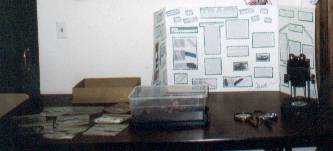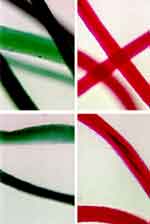 |  |  |  |
 |
 |
 |
 |  |  |  |  |  |  |
 |  |
The trace analysis section is that section of the laboratory which examines evidence that does not conveniently fit into the other classifications. Paint, glass, soil, and fibers however, are the most common types of evidence which are included in trace evidence, and each will be discussed. As can be concluded from the title, trace evidence refers to the size and quantities of evidence that can be collected. Paint chips, a few bits of glass, and soil stuck to shoes are examples. Sometimes relatively large quantities are present but usually just trace amounts are available.
|  |

|  |  |
 |  |  |  |  |  |  |
 |  |
Fibers and Fabric
Fiber examination and fabric comparisons can be encountered in a variety of types of criminal cases. This analysis is performed by a trace analyst.
Fiber identification can be a great value in most types of investigations and prosecutions. Crimes such as murder, rape, accident investigation, robbery and assault can have fiber evidence. Fiber identification can sometimes give important investigation leads as well as good evidence for the prosecution purposes after further analysis is concluded.
1. The type of fiber can be determined by microscopic, chemical, or instrumental tests either when found individually or as part of a fabric. Synthetics, like polyester, nylon, etc., constitute the majority of fibers used in the U.S. today. Wools, camel hair, and silk are examples of fibers from animal sources. Cotton, linen, hemp fibers, and jute are examples of plant fibers. The wood fibers in paper are also fibers of vegetable origin. Asbestos is a mineral fiber.
2. Comparisons of fibers of the same type of material include the presence of dyes and a number of microscopic features. Comparisons can be made with fibers from a fabric to individual fibers or from fibers removed from another piece of fabric. A fiber match, however, constitutes only class evidence.
3. The weave pattern of fabrics can also be compared, and sometimes, when a piece has been torn from a fabric, that piece can be matched up with weave pattern and irregularities of a mutual tear edge. This is a example of individual characteristics.
4. Similarly, cordage (ropes, string, etc.) tears and cuts can be matched if the ends are not too frayed or distorted.
5. Fabric impressions may be found in a number of situations. The impression of a victim's garment may remain on the oil pan or on another flat surface of a vehicle in an accident investigation.
Collection of Evidence
1. Since fiber evidence is generally small in nature, care should be taken to prevent loss or contamination.
2. Several methods could be used in the collecting of fiber evidence: visual searches, alternate light sou~rces and searches with additional magnification.
3. Recovery of evidence should be the most direct but least intrusive technique practical. This could include picking, scraping, or vacuuming.
4. Wrap clothing or items to protect adhering fibers if collection is to be done by laboratory personnel.
5. Known samples should also be submitted for comparison purposes.
6. All items should be sealed and labeled for identification.
Paint
Paint chips and paint scrapings can be left in the clothing of a hit-and-run victim or transferred to or from a car that has been hit by the hit-and-run vehicle. Paint chips or scrapings from a house or business can also be in the clothing or on the tools of a burglar. Criminal mischief cases frequently include paint evidence.
Depending on the amount of sample, paints can be analyzed to determine their pigments and the specific type of paint. The make, model, and year of a vehicle sometimes can be determined from paint samples of the original finish. Most important, however, is the comparison of the chip or scraping to a known sample coming from the suspected source vehicle or building.
Collection of Evidence.
1. All samples from painted surfaces should be collected in such manner as to obtain a paint sample with all the layers of paint present. In other words, the sample should be chipped off down to the unpainted surface. Chips are then to be put in one of the metal "pillboxes" provided in Trace Evidence Kits. Do not use tape to transfer or pick up paint samples.
2. It is sometimes more desirable to submit an easily removed item (trim or molding from a vehicle) as is and let the laboratory remove any foreign paint
3. If submitting clothing for trace paint analysis, air dry and the place each garment in a separate bag.
4. If submitting a tool for paint analysis, wrap the ends in plastic or place it in one of the plastic bags in the Trace Evidence Kit.
5. Identifying marks should be placed on the sample containers.
|  |
|  |  |
 |  |  |  |  |  |  |
 |
|
|
 |
|



